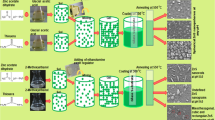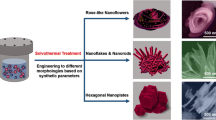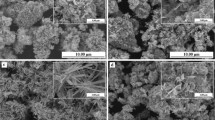Abstract
ZnO nanomaterials are synthesized using one-pot synthesis method. Equimolar solution of Zinc Nitrate hexahydrate (Zn(NO3)2.6H2O) and Hexamethylenetetramine (C6H12N4) is used as a precursor for ZnO formation. Different nanostructures of ZnO are achieved by controlling the pH of the growth solution in the range 2–12 (acidic to alkali). ZnO nanostructures are evaluated for hydrophobic property using static contact angle measurement setup and UV photosensing activity. Surface morphology, structural properties and compositional analysis of ZnO nanostructures are examined by field emission scanning electron microscope (FE-SEM), energy dispersive X-ray analysis (EDX), high-resolution transmission electron microscope (FEG-TEM) and X-ray diffraction (XRD) measurements. Existence of ZnO wurtzite structure is confirmed from XRD study and is analyzed by Rietveld refinement method. Nanomaterials are characterized using Raman spectroscopy which confirms highest oxygen deficiency in ZnO nanorods. The material shows remarkable superhydrophobic and UV photosensing property and hence the name multifunctional. Among all morphologies grown at different pH values, ZnO nanorods show superhydrophobic nature with contact angle more than 170°. Total surface energy value of ZnO nanostructures is calculated using Wendt two-component theory. Different ZnO nanostructures (with variation of pH value) are used to study UV photosensing property. Responsivity and photocurrent show a strong dependence on the morphology of ZnO.


















Similar content being viewed by others
References
Agnihotri S, Bajaj G, Mukherjee S, Mukherjee S (2015) Arginine assisted immobilization of silver nanoparticles on ZnO nanorods: an enhanced and reusable antibacterial substrate without human cell cytotoxicity. Nanoscale 7:7415–7429
Cassie ABD, Baxter S (1944) Wettability of porous surfaces. Trans Faraday Soc 40:546–551
Chang WC, Cheng YY, Yu WC, Yao YC, Lee CH, Ko HH (2012) Enhancing performance of ZnO dye-sensitized solar cells by incorporation of multiwalled carbon nanotubes. Nanoscale Res Lett 7:166
Chen J, Min F, Liu L (2019) The interactions between fine particles of coal and kaolinite in aqueous, insights from experiments and molecular simulations. Appl Surf Sci 467–468:12–21
Chithra MJ, Sathya M, Pushpanathan K (2015) Effect of pH on crystal size and photoluminescence property of ZnO nanoparticles prepared by chemical precipitation method 28:394–404
Choi MY, Choi D, Jin MJ, Kim I, Kim SH, Choi JY, Lee SY, Kim JM, Kim SW (2009) Mechanically powered transparent flexible charge-generating nanodevices with piezoelectric ZnO nanorods. Adv Mater 21(21):2185–2189
Dai W, Pan X, Chen C, Chen S, Chen W, Zhang H, Ye Z (2014) Enhanced UV detection performance using a Cu-doped ZnO nanorod array film. RSC Adv 4:31969–31972
Demianets LN, Kostomarov DV, Kuz’mina IP, Pushko SV (2002) Mechanism of growth of ZnO single crystals from hydrothermal alkali solutions. Crystallogr Rep 47:S86– S98
Devaraj R, Karthikeyan K, Jeyasubramanian K (2013) Synthesis and properties of ZnO nanorods by modified pechini process. Appl Nanosci 3:37–40
Dimapilis EAS, Hsu CS, Mendoza RMO, Lu MC (2018) Zinc oxide nanoparticles for water disinfection. Sustain Env Res 28:47–56
Djurišić AB, Chen X, Leung YH, Man CN (2012) Alan, ZnO nanostructures: growth, properties and applications. J Mater Chem 22:6526–6535
Doan VY, Vuong PH, Lan H, Tam PD (2016) Synthesis of ZnO nanorod for immunosensor application. Vietnam J Chem 54(6):765–770
Ghosh SP, Das KC, Tripathy N, Bose G, Kim DH, Lee TI, Myoung JM, Kar JP (2016) Ultraviolet photodetection characteristics of Zinc oxide thin films and nanostructures. IOP Conf Ser Mater Sci Eng 115:012035
Khokhra R, Bharti B, Lee HN, Kumar R (2017) Visible and UV photo-detection in ZnO nanostructured thin films via simple tuning of solution method. Sci Rep 7:15032
Khranovskyy V, Yakimova R (2012) Morphology engineering of ZnO nanostructures. Phys B 407:1533–1537
Kim D, Kim W, Jeon S, Yong K (2017) Highly efficient UV-sensing properties of Sb-doped ZnO nanorod arrays synthesized by a facile, single-step hydrothermal reaction. RSC Adv 7:40539–40548
Kumar M, Jeong H, Lee D (2019) UV photodetector with ZnO nanoflowers as an active layer and a network of Ag nanowires as transparent electrodes. Superlattices Microstruct 126:132–138
Kundu S, Majumder R, Ghosh R, Pal Chowdhury M (2019) Superior positive relative humidity sensing properties of porous nanostructured Al:ZnO thin films deposited by jet-atomizer spray pyrolysis technique. J Mater Sci Mater Electron 2019:1–8
Lee M, Kwak G, Yong K (2011) Wettability control of ZnO nanoparticles for universal applications. ACS Appl Mater Interfaces 3:3350–3356
Li WJ, Shi EW, Zhong WZ, Yin ZW (1999) Growth mechanism and growth habit of oxide crystals. J Cryst Growth 203:186–196
Li S, Hu J, Li J, Tian J, Han Z, Zhou X, Chen Y (2011) Anisotropic wet etched silicon substrates for reoriented and selective growth of ZnO nanowires and enhanced hydrophobicity. Langmuir 27:6549–6553
Li CP, Zhang J, Yu HM, Zhang LJ (2013) Raman and photoluminescence properties of ZnO Nanorods with wurtzite structure. Key Eng Mater 538:50–53
Medina J, Bolaños H, Mosquera-Sanchez LP, Rodriguez-Paez JE (2018) Controlled synthesis of ZnO nanoparticles and evaluation of their toxicity in Mus musculus mice. Int Nano Lett 8:165–179
Motevalizadeh L, Heidary Z, Abrishami ME (2014) Facile template-free hydrothermal synthesis and microstrain measurement of ZnO nanorods. Bull Mater Sci 37:397–405
Mudunkotuwa IA, Rupasinghe T, Wu CM, Grassian VH (2012) Dissolution of ZnO nanoparticles at circumneutral pH: a study of size effects in the presence and absence of citric acid. Langmuir 28:396403
Orlov A, Ulianova V, Zazerin A, Bogdan O, Pashkevich G, Yakymenko Y (2016) Active elements on a basis of ZnO nanorods for energy harvesting devices. Radioelectron Commun Syst 59:60–65
Park JH, Park JH, Biswas P, Kwon DKH, Sun W, Baik HK, Myoung JM (2016) Adopting novel strategies in achieving high-performance single-layer network structured ZnO nanorods thin film transistors. ACS Appl Mater Interfaces 8:11564–11574
Peng X, Wang W, Zeng Y, Pan X, Ye Z, Zeng Y (2018) Enhanced photoresponse of a high-performance self-powered UV photodetector based on ZnO nanorods and a novel electrolyte by the piezo-phototronic effect. R Soc Chem 8:33174–33179
Prakash GV, Pradeesh K, Kumar A, Kumar R, Rao SV, Markham M, Baumberg J (2008) Morphological manipulation of the nonlinear optical response of ZnO thin films grown by thermal evaporation. Mater Lett 62:1183–1186
Purwaningsih SY, Pratapa S, Triwikantoro, Darminto (2016) Nano-sized ZnO powders prepared by coprecipitation method with various pH. AIP Conf Proc 1725:020063
Ramimoghadam D, Hussein M, Taufiq-Yap YH (2013) Synthesis and characterization of ZnO nanostructures using palm olein as biotemplate. Chem Cent J 7:71
Rodwihok C, Choopun S, Ruankham P, Gardchareon A, Phadungdhitidhada S, Wongratanaphisan D (2017) UV sensing properties of ZnO nanowires/nanorods. Appl Surf Sci. https://doi.org/10.1016/j.apsusc.2017.11.056
Sarahnaz S, Gujela OP, Afzulpurkar NV (2013) Fabrication of light emitting diode with ZnO nanorods on polymer coated silicon substrate. Int Conf Manipul Manuf Meas Nanoscale 2013:295–298
Sarangi SN (2016) Controllable growth of ZnO nanorods via electrode position technique: towards UV photodetection. J Phys D Appl Phys 49:355103
Sarkar S, Basak D (2015) Understanding of ultraviolet photoresponse properties of ZnO nanorods: effect of nanorod’s size and ambient. Sci Lett J 5:4
Sasmal AK, Mondal C, Sinha AK, Gauri SS, Pal J, Aditya T, Ganguly M, Dey S, Pal T (2014) Fabrication of superhydrophobic copper surface on various substrates for roll-off, self-cleaning, and water/oil separation. ACS Appl Mater Interfaces 6:22034–22043
Schuster JM, Schvezov CE, Rosenberger MR (2015) Analysis of the results of surface free energy measurement of Ti6Al4V by different methods. Procedia Mater Sci 8:732–741
Selvarajan E, Mohanasrinivasan V (2013) Biosynthesis and characterization of ZnO nanoparticles using lactobacillus plantarum vites 07. Mater Lett 112:180–182
Shahabi S, Najafi F, Majdabadi A (2014) Effect of gamma irradiation on structural and biological properties of a PLGA-PEG-hydroxyapatite composite. Sci World J 2014:1–9
Shaikh SK, Ganbavle VV, Inamdar SI, Rajpure KY (2016) Multifunctional zinc oxide thin films for high-performance UV photodetectors and nitrogen dioxide gas sensors. RSC Adv 6:25641–25650
Sirelkhatim A, Mahmud S, Seeni A, Kaus NHM, Ann LC, Bakhori SKM, Hasan H, Mohamad D (2015) Review on zinc oxide nanoparticles: antibacterial activity and toxicity mechanism. Nano-Micro Lett 7:219–242
Smeraldi J, Ganesh R, Hosseini T, Khatib L, Olson B, Rosso D (2017) Fate and toxicity of zinc oxide nanomaterial in municipal wastewaters. Water Environ Res 89:880–889
Soci C, Zhang A, Xiang B, Dayeh SA, Aplin DPR, Park J, Bao XY, Lo YH, Wang D (2007) ZnO nanowire UV photodetectors with high internal gain. Nano Lett 7:1003–1009
Sohn JI, Hong WK, Lee S, Lee S, Ku J, Park YJ, Hong J, Hwang S, Park KH, Warner JH, Cha S, Kim JM (2014) Surface energy-mediated construction of anisotropic semiconductor wires with selective crystallographic polarity. Sci Rep 4:5680
Stalder AF, Melchior T, Müller M, Sage D, Blu T, Unser M (2010) Low-bond axisymmetric drop shape analysis for surface tension and contact angle measurements of sessile drops. Colloids Surf A Physicochem Eng Aspects 364:72–81
Sun B, Sirringhaus H (2005) Solution-processed zinc oxide field-effect transistors based on self-assembly of colloidal nanorods. Nano Lett 12:2408–2413
Sun ZP, Liu L, Zhang L, Jia DZ (2006) Rapid synthesis of ZnO nanorods by one-step, room-temperature, solid-state reaction and their gas-sensing properties. Nanotechnology 17(9):2266
Tak M, Gupta V, Tomar M (2015) A highly efficient urea detection using flower-like zinc oxide nanostructures. Mater Sci Eng C 57:38–48
Talam SA, Karumuri SRA, Gunnam NA (2012) Synthesis, characterization, and spectroscopic properties of ZnO nanoparticles, ISRN Nanotechnol 2012:6
Tan ST, Chen BJ, Sun XW, Fan WJ, Kwok HS, Zhang XH, Chua SJ (2005) Blue shift of optical band gap in ZnO thin films grown by metal-organic chemical-vapor deposition. J Appl Phys 98:013505
Torchinsky I, Rosenman G (2009) Wettability modification of nanomaterials by low-energy electron flux. Nanoscale Res Lett 4:1209–1217
Udom I, Ram MK, Stefanakos EK, Hepp AF, Goswami DY (2013) One dimensional-ZnO nanostructures: synthesis, properties and environmental applications. Mater Sci Semicond Process 16:2070–2083
Vicente CMS, André PS, Ferreira RAS (2012) Simple measurement of surface free energy using a web cam. Rev Brasil Ensino Física 34:1–5
Wahab R, Ansari S, Kim Y, Seo H, Kim G, Khang G, Shin HS (2007) Low temperature solution synthesis and characterization of ZnO nano-flowers. Mater Res Bull 42:1640–1648
Wang Z (2004) Zinc oxide nanostructures: growth, properties and applications. J Phys Condens Matter 16:R829
Wang B, Zhang Z, Chang K, Cui J, Rosenkranz A, Yu J, Lin CT, Chen G, Zang K, Luo J, Jiang N, Guo D (2018) New deformation-induced nanostructure in silicon. Nano Lett 18:4611–4617
Wenzel RN (1936) Resistance of solid surfaces to wetting by water. Ind Eng Chem 28:988–994
Yin YT, Wu SH, Chen CH, Chen LY (2011) Fabrication of ZnO nanorods in one pot via solvothermal method. J Chin Chem Soc 58:749–755
Yin Y, Sun Y, Yu M, Liu X, Yang B, Liu D, Liu S, Cao W, Ashfold MNR (2014) Controlling the hydrothermal growth and the properties of ZnO nanorod arrays by pre-treating the seed layer. RSC Adv 4:44452–44456
Zanni E, Bruni E, Chandraiahgari CR, De Bellis G, Santangelo MG, Leone M, Bregnocchi A, Mancini P, Sarto MS, Uccelletti D (2017) Evaluation of the antibacterial power and biocompatibility of zinc oxide nanorods decorated graphene nanoplatelets: new perspectives for antibiodeteriorative approaches. J Nanobiotechnol 15:57
Zhai T, Xie S, Zhao Y, Xiaofeng S, Lu X, Yu M, Xu M, Xiao F, Tong Y (2012) Controllable synthesis of hierarchical ZnO nanodisks for highly photocatalytic activity. Cryst Eng Comm 14:1850–1855
Zhang R, Yin PG, Wang N, Guo L (2009) Photoluminescence and Raman scattering of ZnO nanorods. Solid State Sci 11:865–869
Zhang Z, Song Y, Huo F, Guo D (2012a) Nanoscale material removal mechanism of soft-brittle HgCdTe single crystals under nanogrinding by ultrafine diamond grits. Tribol Lett 46:95–100
Zhang Z, Song Y, Xu C, Guo D (2012b) A novel model for undeformed nanometer chips of soft-brittle HgCdTe films induced by ultrafine diamond grits. Scr Mater 67:197–200
Zhang Z, Huo F, Zhang X, Guo D (2012c) Fabrication and size prediction of crystalline nanoparticles of silicon induced by nanogrinding with ultrafine diamond grits. Scr Mater 67:657–660
Zhang G, Wei L, Chen Y, Mei L, Jiao J (2013a) Field emission property of ZnO nanoneedle arrays with different morphology. Mater Lett 96:131–134
Zhang Z, Huo Y, Guo D (2013b) A model for nanogrinding based on direct evidence of ground chips of silicon wafers. Sci China Technol Sci 56:2099–2108
Zhang Z, Wang B, Kang R, Zhang B, Guo D (2015) Changes in surface layer of silicon wafers from diamond scratching. CIRP Ann 64:349–352
Zhang Z, Wang B, Huang S, Wen B, Yang S, Zhang B, Lin CT, Jiang N, Jin Z, Guo D (2016a) A novel approach to fabricating a nanotwinned surface on a ternary nickel alloy. Mater Design 106:313–320
Zhang Z, Wang B, Zhou P, Kang R, Zhang B, Guo D (2016b) A novel approach of chemical mechanical polishing for cadmium zinc telluride wafers. Sci Rep 6:26891
Zhang Z, Wang B, Zhou P, Guo D, Kang R, Zhang B (2016c) A novel approach of chemical mechanical polishing using environment-friendly slurry for mercury cadmium telluride semiconductors. Sci Rep 6:22466
Zhang Z, Huang S, Chen L, Wang B, Wen B, Zhang B, Guo D (2017a) Ultrahigh hardness on a face-centered cubic metal. Appl Surf Sci 416:891–900
Zhang Z, Cui J, Wang B, Wang Z, Kang R, Guo D (2017b) A novel approach of mechanical chemical grinding. J Alloy Compd 726:514–524
Zhang Z, Shi Z, Du Y, Yu Z, Guo L, Guo D (2018) A novel approach of chemical mechanical polishing for a titanium alloy using an environment-friendly slurry. Appl Surf Sci 427:409–415
Zhang Z, Cui J, Zhang J, Liu D, Yu Z, Guo D (2019) Environment friendly chemical mechanical polishing of copper. Appl Surf Sci 467–468:5–11
Acknowledgements
The authors would like to thank UGC, India for financial support and Ms. Ria Ghosh acknowledges DST-INSPIRE, India for research fellowship.
Author information
Authors and Affiliations
Corresponding author
Additional information
Publisher’s Note
Springer Nature remains neutral with regard to jurisdictional claims in published maps and institutional affiliations.
Rights and permissions
About this article
Cite this article
Ghosh, R., Kundu, S., Majumder, R. et al. One-pot synthesis of multifunctional ZnO nanomaterials: study of superhydrophobicity and UV photosensing property. Appl Nanosci 9, 1939–1952 (2019). https://doi.org/10.1007/s13204-019-00985-8
Received:
Accepted:
Published:
Issue Date:
DOI: https://doi.org/10.1007/s13204-019-00985-8




